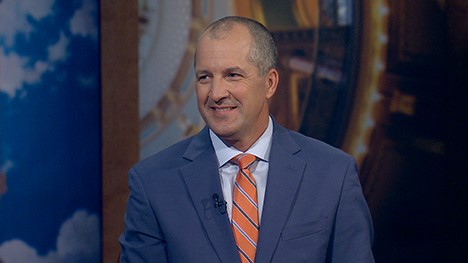CLICK HERE for the latest market quotes from the Iowa Agribusiness Network!
CLICK HERE for the latest market quotes from the Brownfield Ag News Network!
CLICK HERE for the latest market quotes from the Iowa Agribusiness Network!
CLICK HERE for the latest market quotes from the Brownfield Ag News Network!
(Radio Iowa) – A northern Iowa organization called “Hunting with Heroes” is gearing up for an annual pheasant hunt later this week in Kossuth County. Bernie Becker, a spokesperson for the group, says six veterans from other states who’ve been wounded in combat will go hunting and four veterans who’ve been guests of the group before will be mentors. “We have probably about 1500 acres lined up that’s never been hunted just for these guys to hunt this year and we’re really looking forward to it,” Becker says. “We’ve got a great bunch of guys coming. We’ve talked to them and they’ve been chosen by people that have been here before and they are capable of doing the hunt because it’s kind of strenuous for combat wounded guys.”
Becker says they try to make sure the wounded vets are comfortable handling new shotguns. “The first day they come in we take them to a sporting club and get them used to shooting these new shotguns that we provide for them and we donate them to them to take home,” Becker said. “We try to hunt about two hours and then we take a break. Everybody has to catch their breath, even me, and then we go back at it again.”
The wounded veterans participating this year are flying in tomorrow (Thursday) and they’ll be hunting in Kossuth County this Friday, Saturday and Sunday. On Veterans Day, they’ll participate in an annual food distribution event in the small Kossuth County town of Lakota. Last year, the group provided over 500 complete Thanksgiving meals to area veterans and the widows of veterans. Becker says this year they’re planning on handing out over 600 meals for the upcoming holiday.
(Council Bluffs, Iowa) – Officials with AgriVision Equipment and PrairieLand Partners have announced the Next-Gen Tech Expo will take place this Saturday, November 8, 2025, from 9:00 a.m. until 3:00 p.m., at the WeLead Training Center in Council Bluffs. The event provides a unique opportunity for high school juniors and seniors interested in becoming agricultural technicians to showcase their mechanical knowledge, critical thinking, and problem-solving skills, all while engaging with industry professionals.
Throughout the day, students will take part in a series of interactive challenges. Top performers for the day, will not only earn prizes but also be considered for a spot in the 2026 class of the WeLEAD Tech Institute, a program dedicated to developing the next generation of highly skilled service technicians. While students compete, parents will have the opportunity to explore the many ag tech education and career pathways available through partnerships with AgriVision Equipment and PrairieLand Partners.
(Radio Iowa) – Iowa Congressman Zach Nunn and a small group of central Iowans from the ag sector say farmers don’t like bailouts, but emergency federal assistance is needed after tariff tensions roiled the grain markets. Vernon Flinn, who raises corn, soybeans and cattle in five central Iowa counties, says he’s prefer to have the free market dictate prices — but short term help is needed.
“Part of the problem we’re facing is brought on by the government, so I think the government’s got an obligation to help maybe bail guys out of it,” Flinn said. Flinn recently paid a huge bill to replace two tires that were punctured when the combine rolled over a set of deer antlers in a field. “(With) $4 corn, there’s not a lot of money to go around to buy $26,000 tires,” Flinn said.
Nunn, a Republican from Ankeny, says President Trump’s recent negotiations with China will yield results for Iowa soybean farmers — and the Big Beautiful Bill Trump signed in July provides tax benefits to farmers. “No farmer that I’ve ever talked ever says they want a bailout. What they’d like to be able to do is expand their market — that’s both internationally, as the president just showed in his Asia trip, but it’s also domestically — something that the Biden Administration failed to do for us for four years, something that this administration can do for us right now,” Nunn says.
“It’s one of the reasons I just had a conversation with (Treasury) Secretary Bessent about opening up E15 year round…and expansion of biofuel consumption in the U.S.” Nunn hosted a roundtable discussion yesterday (Tuesday) at the Heartland Co-op in Carlisle. Tom Hauschel (HAH-shell) is the co-op’s C-E-O. “We’re off to a very difficult start this year, with the farm economy what it has been and the crop size with all the fungus and rust that we had,” Hauschel said. “It’s the most stressful year we’ve had in the entire history of the cooperative.”
The Heartland Co-op was formed in 1987 with the merger of co-ops in Panora, Dallas Center, Minburn and Granger and it expanded in 1993 when a grain business in Carlisle and co-ops in Alleman and Mitchellville joined the enterprise. Hauschel says the financial pressure that started at the farm gate is now being felt at the retail level and federal officials need to develop a long-term plan for the ag sector.
“Payments are a short-term fix. It’s not going to solve the problem next year because if we don’t move this ball forward, we’re not going to solve next year’s problems,” Hauschel said, “so this problem is just going to snowball and then we’re going to lose farmers. We’re going to lose the young kids.”
A recent Creighton University survey of rural bank C-E-Os in Iowa and other Midwest states found a firm majority of the bankers believe President Trump’s approach to trade with China is about right, but nearly 85 percent of the bankers surveyed support emergency federal payments to farmers due to the financial hit of trade losses.
Wednesday, November 5th, Atlantic-native Glen Smith will sit for a congressional hearing on his appointment as United State Department of Agriculture Undersecretary of of Rural Development. Smith, Who served as President of the Farm Credit Administration, said this process began in April.
Smith said the F-C-A confirmation process was not quite this involved.
Smith says he’s honored to have the opportunity to work at the U-S-D-A.

Glen R. Smith (Official FCSIC photo)
The hearing is scheduled for Wednesday, November 5th at 2:00 pm central time and can be viewed at:
https://www.agriculture.senate.gov/hearings/nomination-hearing-11-05-2025.
(Radio Iowa) – A new statewide initiative is being launched that will help support community gardens that donate fresh produce. The Iowa Donation Garden Network is designed to reach and link up garden organizers through expert-led education, shared resources and collaborative programming. Alicia Herzog, the Iowa Master Gardener program manager with I-S-U Extension and Outreach, explains how it’ll work. “The overarching goal of this network is to empower and connect community donation gardens across Iowa,” Herzog says. “It can feel like you’re an island, sometimes, trying to do this work of raising fresh produce to be donated to food pantries in the area and battling food insecurity in the local community.” There are dozens, perhaps hundreds, of community gardens across Iowa that are helping to feed people in their immediate areas. Through this new network, Herzog says they hope to get a handle on roughly how many gardens are doing this good work across Iowa, and how much produce they’re donating.
“We’ll be asking the member gardens to provide us some basic annual reporting metrics that then we can help create a statewide map,” Herzog says, “and we can show all of the communities, all of the counties that are impacted by these different gardens.” Exact locations won’t be published, she says, as they don’t want gardens being overrun. Funding will end this year for the U-S-D-A’s Supplemental Nutrition Assistance Program-Education, referred to as SNAP-Ed, so Herzog says the new network fills a critical gap in statewide support for donation gardens. “I’m sure that we won’t catch every donation garden that exists in Iowa, but we’re really trying to cast that net wide and far and let any donation garden that exists know that we want you to be a part of this story,” Herzog says. “We want to help tell your story about the good work that you may already be doing in your community and how that fits into the puzzle.”
Informational Zoom sessions to introduce the Iowa Donation Garden Network will be held tomorrow (Tuesday) at 9 AM, noon and 6 PM. Go here to register:
https://www.extension.iastate.edu/mastergardener/iowa-donation-garden-network
Officials with the Iowa Natural Heritage Foundation have announced they have reached the Foundation’s $1.9 million fundraising goal for the Arnolds Park Nature Area and will purchase the property to ensure it is protected and open to the public.
In a press release, the INHF said a flurry of donations over the final weeks of the campaign made it possible for INHF to exercise an option to purchase the 73-acre property before an Oct. 31 deadline. More than 300 individuals and families donated to support the vision for a city-owned park in the heart of the Iowa Great Lakes, managed with water quality, flood reduction, wildlife habitat and outdoor recreation in mind.
INHF partnered with the city of Arnolds Park, Ducks Unlimited and Dickinson County Conservation to raise the necessary funding. Dozens of community partners — including East Okoboji Lakes Improvement Corporation, the Okoboji Protective Association and Iowa Great Lakes Pheasants Forever — championed the project and made meaningful contributions. 
After closing on the sale, INHF will place a conservation easement on the property, ensuring its permanent protection. INHF will then transfer ownership to the city of Arnolds Park, and work with partners to plan for wetland and prairie restoration work on the site. The city plans to install a small parking area, a picnic shelter, and soft surface trails through the park. Eventually, an off-road bike trail along the east side of the property will connect the Great Lakes Spine Trail north toward Bridges Bay. Any funds raised in excess of the purchase price will go directly toward the native habitat restoration happening on site.
INHF is grateful to all the partners and supporters that made this project possible. Your efforts are improving the quality of life for Great Lakes-area residents and visitors and supporting INHF’s mission to protect and restore Iowa’s land, water and wildlife.
Supporters that made a pledge to the project can make a pledge payment online or send a check in the mail to:
Iowa Natural Heritage Foundation
505th Ave, Ste 444
Des Moines, IA 50309
(Radio Iowa) – Sightings of mountain lions in the state have dropped, but Iowa D-N-R furbearer biologist Vince Evelsizer says there are still some of the animals out there.
There also continue to be sightings in the northern corner of the state.
Evelsizer says the big cats try to stay away from humans, but there is a chance you could see them during the winter.
 There haven’t been many recent bear sightings, but Evelsizer says there are still some out there as well.
There haven’t been many recent bear sightings, but Evelsizer says there are still some out there as well.
Evelsizer says the bears will soon head into their dens for their long winter nap.
Evelsizer says bear sightings always pick up in the spring when they come out of hibernation and are hungry and looking for food.
(Radio Iowa) – President Trump met with China’s president earlier today (Thursday) and Trump says China has agreed to start buying massive amounts of U.S. soybeans. U-S Ag Secretary Brooke Rollins says China purchased “multiple” shiploads of soybeans just before the meeting. Iowa Secretary of Agriculture Mike Naig says it’s all great news that will have a meaningful impact at a tough time for the farm economy. China has historically been the largest overseas market for U.S. soybeans, but stopped buying this spring in response to U.S. tariffs. American Soybean Association President Caleb Ragland says that made financial problems even worse for soybean farmers.

Iowa Secretary of Agriculture Mike Naig on the “Iowa Press” set at Iowa PBS (Iowa PBS photo)
“We are hopeful that this market will be restored following the meeting between Presidents Trump and Xi,” Ragland said. “Still, high production costs and market losses mean soybean farmers are expected to face losses of $109 per acre for this year’s crop.” Ragland says the financial situation for row crop farmers remains dire, though, due to escalating costs for things like seeds, fertilizer and farm equipment. “As congress and the administration continue to address the overall cost of farm production, targeted farm assistance is desperately needed,” Ragland said.
President Trump suggested weeks ago that up to 10 BILLION dollars of emergency payments to farmers could be made using tariff revenue, but the plan was put on hold during the government shutdown.
(Atlantic, Iowa) – Farmers are pondering the question of whether or not this is a good time to apply anhydrous ammonia to their fields after the harvest. Aaron Saeugling ISU Extension/Outreach Field Agronomist for Cass County says it’s a “difficult question to answer, with several variables,” but Saeugling says “I will say NO it is still too warm we need soils to cool a bit further to reduce the conversion to nitrate. We want spoils that are trending downward in temperature the 4-inch soil temp fluctuates more in dry soils and with sunny days. Some folks will justify this by that timing to get it all applied is challenging, while I do agree that getting it applied is a challenge just prepare your self to lose more nitrate than if you are to wait.” He urges crop producers to “Be safe!”

More information is available HERE.
(Red Oak, Iowa) – The Board of Supervisors in Montgomery County are being asked to contribute to a case involving local control of carbon pipeline projects. During the Board’s meeting Tuesday morning in Red Oak, West Township resident Jan Norris asked them to approve the Iowa State Association of Counties (ISAC) request for funding for an Amicus brief in an upcoming U.S. Supreme Court case.
Each of the Montgomery County Board of Supervisors received a letter from ISAC asking for a donation. An amicus brief is a legal document submitted by a third party who is not directly involved in a lawsuit but has a strong interest in the outcome. Related legal terminology, “amicus curiae” translates to “friend of the court,” and the brief’s purpose is to provide the court with additional information, expertise, or arguments that can help inform its decision. Those briefs are often filed in cases of public importance and can support or oppose a party’s position by offering unique perspectives or legal analysis
Earlier this month, Shelby and Story County officials filed a petition in their case against Summit Carbon Solutions. Both counties seek to appeal the Eighth Circuit Court of Appeals’ ruling in June that upheld a lower court’s ruling barring counties from implementing ordinances regulating carbon sequestration projects–such as the proposed Midwest Express CO2 pipeline.
Norris says ISAC is asking each county to consider a $500 contribution or more, to cover the total cost of $25,000 to file the amicus brief and represent counties during the legal proceedings.
The Board acknowledged the matter is worthy of consideration and discussion, and it will be placed on their agenda for Wednesday, Nov. 5th.